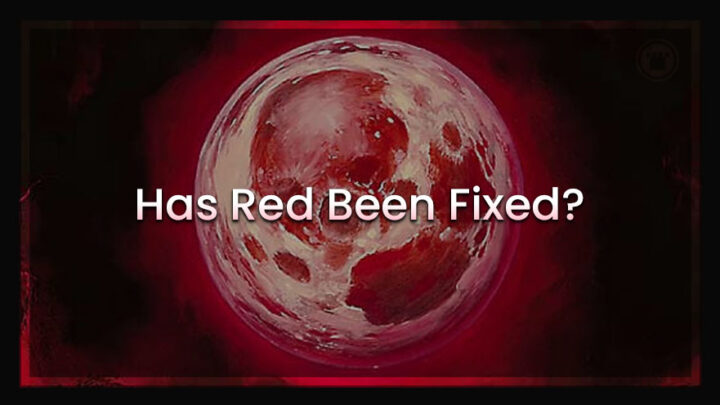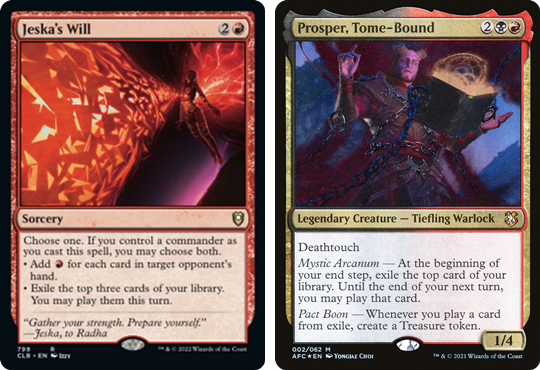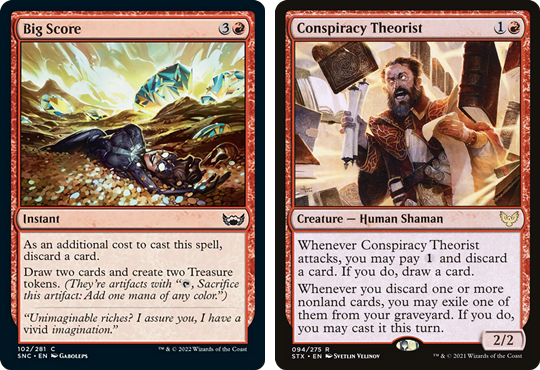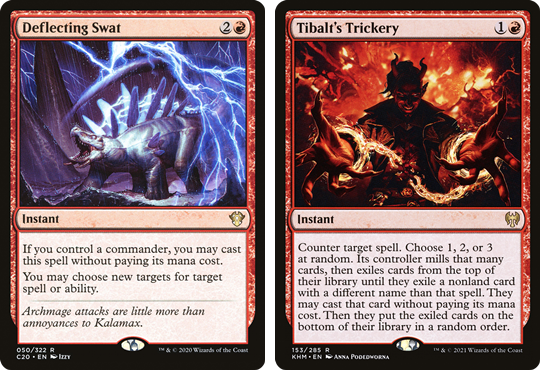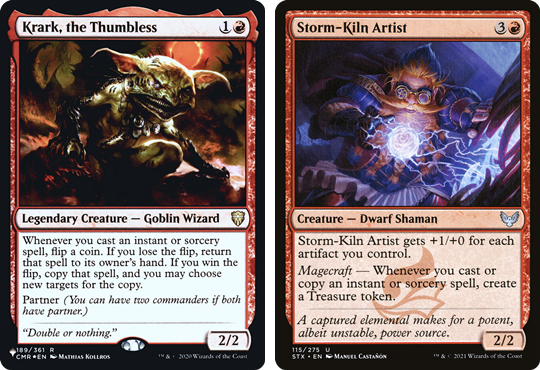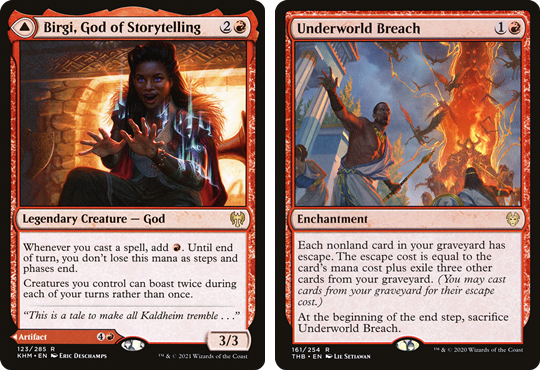Red has changed. Not too long ago, some players called on Wizards of the Coast to “fix” Red in Commander. At the time, that slice of the color pie felt in need of a boost, much like how White felt not too long ago.
While still powerful in formats where Burn decks thrived, Red was far from a good place in Commander for a long time. The color gained a reputation for being one dimensional and quick to peter out in games. And once a color picks up that kind of reputation, it can take a long time to shake it off.
However, after changes during the past couple of years, I think it’s time to give up those old associations. As a staunch Red player who loves nothing more than Storm-Kiln Artists and making the table sweat with a Mana Geyser, I’ve had a front row seat to Red’s development and new strengths.
Impulse Draw
Longevity and sustainability were two of Red’s primary issues in the past. If a game went on for more than a handful of turns, the Red decks would start to run out of options.
This needed addressing, and in a way that made sense for Red’s identity. You couldn’t just color-shift a few Divinations or Sign in Bloods and call it a day. The solution had to feel distinctly Red.
Impulse draw, it turns out, was the perfect answer.
Impulsivity is one of Red’s primary traits, and impulse draw captures that sentiment well. The mechanic gives you the cards you need now, but if you don’t use them, you lose them.
Impulse draw is named after Act on Impulse, one of the first cards to feature this style of card advantage. For years, there were very few impulse draw options, but new Commander staples like Jeska’s Will and Reckless Impulse have changed things. These are Red’s new bread and butter for card advantage, and there are new variations of this effect in almost every new set.
There are also payoffs for either exiling cards from your library or playing them from exile. Perhaps the most (in)famous example is Prosper, Tome-Bound. They’re one of the most popular and powerful commanders in recent memory thanks to their reward of treasures for playing cards from exile.
That being said, this isn’t the only way Red card advantage has improved recently.
Card Filtering
Another one of Red’s strengths is card filtering. Faithless Looting and Cathartic Reunion have been mainstays since their introduction since they let players see so many cards.
These filtering cards have steadily improved over time, with newer introductions like Thrill of Possibility, Electric Revelation and Big Score making impressive marks on Red’s performance. The latter has been particularly impactful thanks to the treasures it produces, which can smooth out your mana or set you up for an explosive turn.
Magic has also introduced cards that help mitigate the “downsides” of running card draw that isn’t inherently seen as card advantage. Conspiracy Theorist and Containment Construct let you play whatever you discard, so you technically don’t lose any cards when you rummage.
Cathartic Pyre is another little addition that gives players the choice between filtering their hand or removing a creature. This one is more unique in that we haven’t seen much of this kind of flexibility yet, but it’s something that will suit Red’s adaptable nature to explore further in the future.
Treasures
Similar to card draw, Red had an issue with mana acceleration for quite some time. Most decks want to go bigger in a format like Commander, and green is exceptional at that thanks to land ramp and mana dorks.
As a result, it can be hard for other colors to keep up with, even when playing mana rocks — and Red was no exception. Rituals like Seething Song and Mana Geyser may be powerful, but they only allow for a single, explosive turn.
More permanent ramp, like land ramp and mana dorks, doesn’t fit in Red’s slice of the pie — so Wizards of the Coast went with something that sat in between temporary and permanent.
Players can spend Treasures immediately for an explosive turn, save them for a bigger turn or just use them to help smooth out your curve. That kind of versatility more than makes up for their one-time use.
However, there’s no way to talk about treasures without mentioning Dockside Extortionist. It has become one of the most divisive cards in Commander thanks to its absurd explosiveness. It can drop on turn three and net several times its mana value in treasures. Alternatively, at tables playing with higher power, it can be flickered, sacrificed and looped repeatedly to great effect.
Dockside is certainly on the more explosive side of things, and the recent printing of Ancient Copper Dragon indicates that this should be considered the norm — at least at higher power tables.
Yet, there is more to treasures than just enabling explosiveness turns. Professional Face-Breaker sparked a lot of interest when first previewed as a way to convert excess treasures into raw card advantage (while also being a treasure generator).
Red is already good at attacking, so it’s easy for this to become a consistent engine, and the creatures lost in combat are replaced by the impulse draw Face-Breaker provides. This gives combat-oriented Red decks the kind of staying power they need to be able to keep up with the likes of green and blue.
In addition to treasures improving acceleration and grind power, there have been a number of other interesting applications for treasures. Magda, Brazen Outlaw has shown she’s worth her weight in gold by turning treasures into powerful artifacts or dragons with little effort. Her ability is so powerful that she’s even had a pretty decent run in cEDH as a combo commander.
Cards like Reckless Fireweaver and Ingenious Artillerist have also started to show up more in the presence of treasures as a way to give decks reach to close out games more reliably.
Some might argue that treasures are getting too good considering the frequency at which they show up and how easily they can be abused. It’s not an unreasonable argument, but since Red is the primary treasure color, that just highlights how much they have done to increase the color’s relevance in Commander.
Answers
Red has historically found it hard to answer most problems, as it struggled to get by with just artifact and damage-based removal. Chaos Warp was forced to do a lot of heavy lifting for years, but that has shifted now with new staple spells appearing in various sets.
Red used to be almost completely unable to interact with spells or abilities on the stack, save for a couple of niche exceptions. Spells like Deflecting Swat and Bolt Bend have changed that by letting you redirect removal to an opposing commander or blow a stack of counterspells apart.
Tibalt’s Trickery is effectively Chaos Warp but for the stack – it’s a hard counter, but the caster will get something in return. Is it better or worse? It doesn’t matter. As long as the initial problem is dealt with, Red doesn’t care.
Wild Magic Surge, meanwhile, is effectively a second copy of Chaos Warp, giving Red decks twice as many ways to indiscriminately remove a permanent. It might not seem like much, but when you’re as strapped for choices as Red has been, these are an enormous boon.
Copying
While treasures and impulse draw are often the first things to come to mind about Red’s improvements recently, one thing that’s often overlooked is its reinvigorated copying abilities. Red has always been one of the primary colors for copying spells and permanents alongside Blue, with the key difference being that Red only copies permanents temporarily. Some new copying cards have had a tremendous impact on Red’s performance lately.
Krark, the Thumbless, from Commander Legends, almost immediately became known for being a powerful cEDH commander, often beside Sakashima of a Thousand Faces. It’s easy to set it up, so you can copy spells without actually resolving the original spell, giving you as many spells as you have the mana to cast them with.
When you add rituals into the mix, you’re on the way to a self-sustaining storm win. It’s possible for Krark to be seen in more casual decks too, but he still causes cold sweats at any table.
While copying spells is relatively common, casting them is even more so. Storm-Kiln Artist is probably my most played card, as their treasure rebate for spells and their copies is frankly disgusting. They’re usually responsible for turns with a storm count in the early double digits, even in decks that don’t run storm cards.
They do work best with Storm cards, and given how much we know treasures have impacted things lately, it’s easy to see how Storm-Kiln Artist could blow you away.
More strategy-specific copies have surfaced recently, too, like Nalfeshnee, Jaxis the Troublemaker and Rionya, Fire Dancer. Nalfeshnee really rewards you for leaning into impulse draw, Jaxis is pretty flexible with some mild discard and sacrifice synergies, and Rionya walks the line between storm and value. These all compliment one or more of the other improved aspects of Red and give the color more ways to keep up with the rest of the color pie in Commander. Choosing the right one of these for your Red deck can really take it to the next level.
Storm
Storm has always been associated with Red thanks to some excellent enablers and payoffs, like rituals, Grapeshot and Past in Flames. Now we have even more pieces to make Red Storm decks scarier than ever. Birgi, God of Storytelling’s mana rebate is a lot like Storm-Kiln Artist’s, and she’s often used alongside the dwarf shaman for double the effect.
Before, if you failed to storm off fully, you’d just lose all of your momentum. Now, Galvanic Relay lets you stockpile another mountain of resources to try again the following turn. And perhaps the most powerful addition is Underworld Breach, which has flipped higher power and cEDH tables on its head by letting players loop cards like Lion’s Eye Diamond and Brain Freeze.
Deck Showcase: Laelia, the Blade Reforged
I wanted to put a deck on display that makes use of a lot of these new cards and mechanics to show how well-rounded and potent Red has become. This is my Laelia, the Blade Reforged deck:
This is my iconic, aggressive midrange deck. It uses Laelia as its primary win condition and makes use of discard synergies in addition to exile-based card advantage to keep up with the rest of the table. There is minimal protection and evasion for Laelia to allow players to interact, but there is a solid amount of value and recursion to ensure you never fall behind if she is removed.
This kind of deck simply could not have existed just three years ago. It’s a testament to the strides Wizards of the Coast has taken to bring Red to the forefront as a powerful and respected color in Commander.
I’m obviously of the opinion that Red has indeed been “fixed,” but I’d love to hear what you think. How do you feel about Red’s metamorphosis in the past few years? Has it gone from being the “problem child” of Commander, to a passionate powerhouse? Do you think there’s still more to be done, or has it become too good? Let me know your thoughts over on Twitter.

Scott is an Irish content creator and the Head of Budget Magic for the Izzet League. He focuses on affordable decks in Pioneer, Modern, and Pauper, particularly ones that stray from the mainstream. When he’s not writing about his favorite decks, he can be found talking incessantly about them on Twitter and on The Budget Magic Cast.

